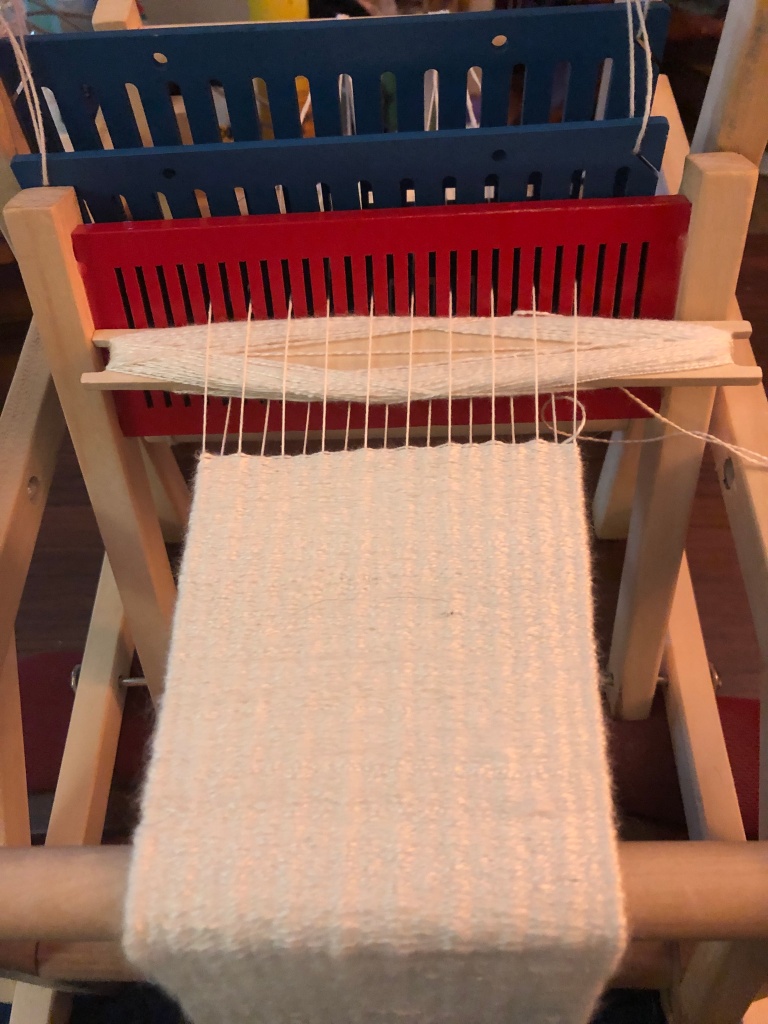So, right now in addition to music, I have been engaging in spinning, using wheels; weaving; and knitting. But mostly spinning and weaving. And like in 12th century of Sicily, I have been spinning and weaving with silk.
Currently I am weaving a sash on my kiddie 2-heddle loom. The sash is being woven on a cotton warp with a weft of two-ply spun silk. Because of the larger width of the spacing in these heddles and the fineness of the yarn, the effect is very interesting, as you can see.



This sash will be dyed yellow and be submitted for the pool of prizes for an SCA tourney in September. The wearer will probably have to pin it closed rather than tie it, as the weave is a little thick, but we shall see once I get it off the loom. Yellow was chosen because it is one of the East Kingdom colors, and it is the color the fighter I am weaving this for has requested.
This is the second sash I have woven on this loom. The weave is not particularly historically accurate, as it’s like an uncut corduroy (but since it’s woven on only two shafts, there is no ground fabric to hold the weaves to cut them and create that fuzzy texture). But I think the effect is interesting and it weaves up easily. And it’s still eminently touchable. Here you can see a corduroy woven in silk, with the weaver explaining the technique.
Now comes the question of, what would a 12th century Sicilian loom have looked like? Although Sicily imported a lot of woven silks, the island also exported silk fabric, as this article attests. (The writer cites a lot of David Abulafia’s works, and he is probably the foremost researcher on medieval Sicilian and Mediterranean production and trade.)
Here is another article talking about the Islamic roots and influence in textile design in Sicily. So, looking at the brocade examples in that article, weaving those designs would take large looms, with at least four shafts (to enable twill weaving and brocade floats), and probably heddles made of thread rather than rigid heddles. I’ve found a photo of an old loom in a medieval house in Italy; this came off a random Pinterest page.

Horizontal looms like this one appeared in China, and probably spread through the silk trade into the Islamic world. When foot pedals were added, this greatly sped up weaving.
The types of surviving cloth from Sicily are complicated brocaded twill weaves. To make the brocaded areas, pickup sticks were possibly used. But I think they just had multishaft looms. Some of the medieval brocade loom weaving techniques may have been preserved in the manufacture of Varanasi saris, which have roots in the 16th century and the Persian Mughal empire.
Incidentally, I tend to use Varanasi-style saris for making my Arabic Sicilian tunics. The handwoven ones are still expensive, but used cheaper machine-woven ones can be found on eBay and of course from certain SCA vendors.
Here is the link to a video on Varanasi hand weavers.
While I would love a multishaft floor loom, the enormous amount of floor space I’d need, the expense of a modern loom (even a used one will cost more than $1,000, and I don’t have the wherewithal to rehab an old or antique one), and the time needed to master such a loom make such an acquisition unlikely. Instead, I am sticking with tabletop rigid heddle looms and learning techniques on them.